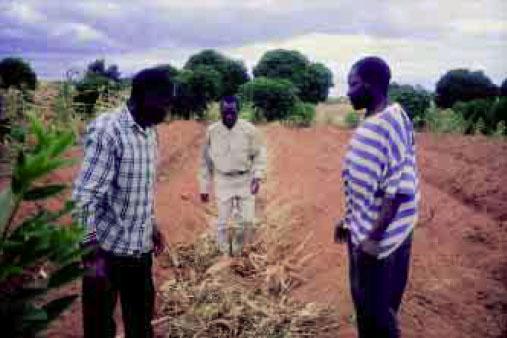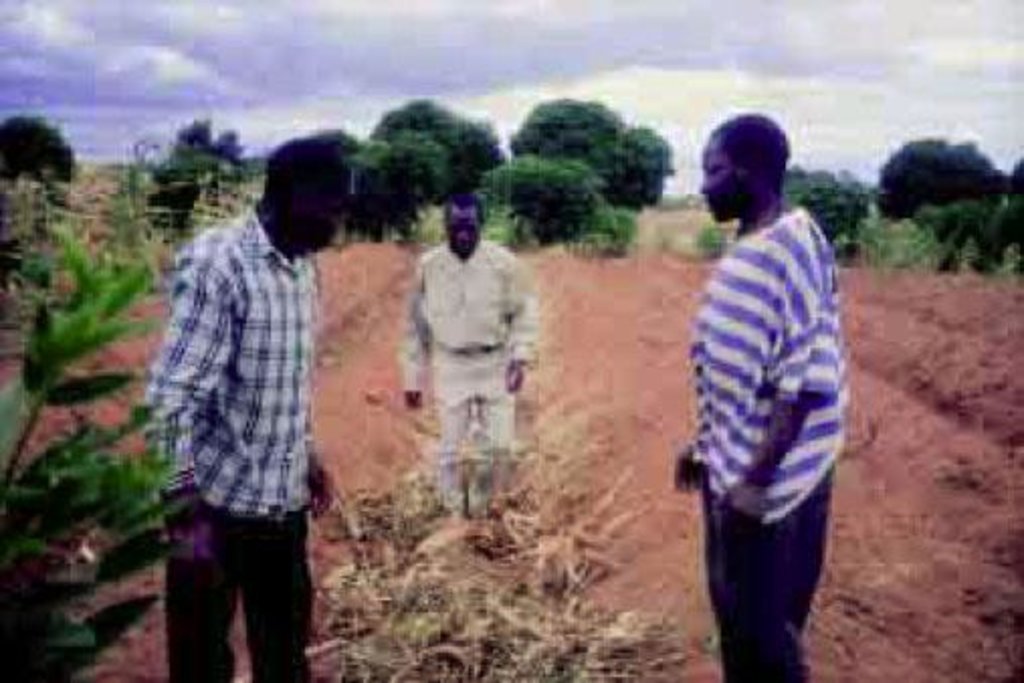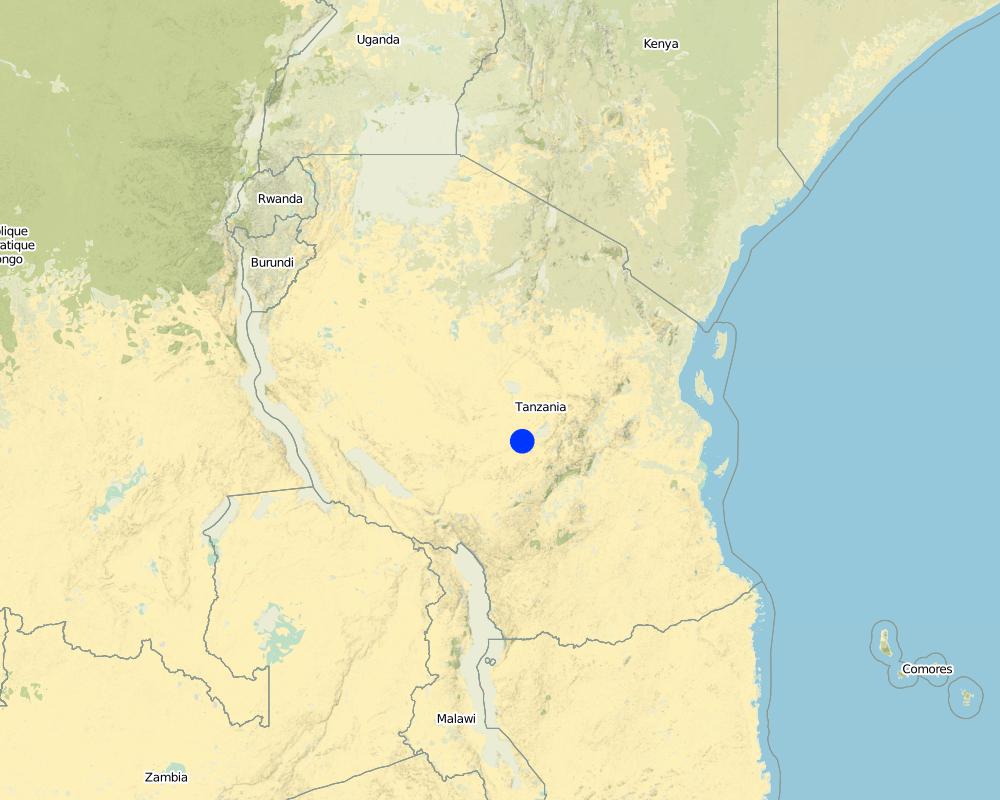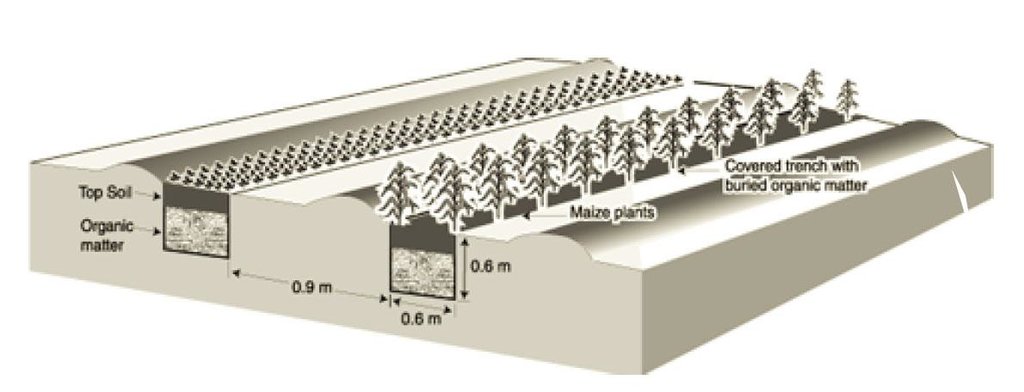In-situ compost cultivation or ‘pattern farming’ [坦桑尼亚联合共和国]
- 创建:
- 更新:
- 编制者: Patrick Gervas Mbanguka Lameck
- 编辑者: –
- 审查者: David Streiff, Alexandra Gavilano
Kilimo cha mfumo (Kiswahili)
technologies_1122 - 坦桑尼亚联合共和国
查看章节
全部展开 全部收起1. 一般信息
1.2 参与该技术评估和文件编制的资源人员和机构的联系方式
有助于对技术进行记录/评估的机构名称(如相关)
Inades Formation Tanzania (Inades Formation Tanzania)1.3 关于使用通过WOCAT记录的数据的条件
编制者和关键资源人员接受有关使用通过WOCAT记录数据的条件。:
是
2. SLM技术的说明
2.1 技术简介
技术定义:
In-situ compost trench cultivation
2.2 技术的详细说明
说明:
The system is based on trench cultivation. This involves excavation of trenches 0.6 m deep and 0.6 m wide, more or less across the slope, at a spacing of 0.9 m apart, edge to edge. The trenches are dug in the dry period, then filled with crop residues, grass and other organic trash, and finally back-filled with soil.
The surface is deliberately left some centimetres below ground level so that it can capture runoff. Associated with the trenching, a furrow to harvest rainwater is formed to lead water into the field from outside, and an end bund in the field is built up to prevent its loss. Between trenches a leguminous crop such as groundnuts is grown, while maize, sweet potatoes and tomatoes are grown on the trenches. In the first year, the farmer plants at the sides of the trench to avoid damage to crop roots by the heat generated by decomposition. Thereafter crops are planted in the middle. In years of good rainfall it is possible to grow an opportunistic second crop, making use of stored soil moisture. After four years the trench is re-dug, filled with organic matter, and the cycle begins. Further additions/ improvements to the system (which is
constantly evolving) are (i) the addition of cattle urine and waste water from the household to hasten decomposition of grass materials; and (ii) mulching between the trenches with crop stover at the end of the season.
Purpose of the Technology: The technology comprises a structural measure, dedicated to improvement of the land for annual cropping. In respect to soil and water conservation it primarily addresses soil fertility and soil moisture problems. It achieves impact through increasing organic matter and water stored in the soil. Ecological benefits include increase in soil moisture, improved soil fertility and protection of the land from surface erosion.
Establishment / maintenance activities and inputs: The land was completely bare before the technology and is now productive. Compared with neighbouring farms yields are estimated to be at least 50% higher, and the farmer considers the benefits to be ‘very positive’ in relation to the costs. This is reflected in his increased farm income. Those cost, however, are estimated at around 400 person days per hectare for initial establishment.
Natural / human environment: This technology was designed by a retired agricultural field agent on his 3 ha of land. The importance of this particular innovation lies in the fact that the originator has mixed and matched tradition and modern practices to tailor-make a system that suits his own situation.
2.3 技术照片
2.5 已应用该技术的、本评估所涵盖的国家/地区/地点
国家:
坦桑尼亚联合共和国
区域/州/省:
Dodoma
有关地点的进一步说明:
Dodoma rural
具体说明该技术的分布:
- 均匀地分布在一个区域
如果不知道精确的区域,请注明大致覆盖的区域:
- 10-100 平方千米
Map
×2.6 实施日期
如果不知道确切的年份,请说明大概的日期:
- 不到10年前(最近)
2.7 技术介绍
详细说明该技术是如何引入的:
- 通过土地使用者的创新
注释(项目类型等):
farmer intiative
3. SLM技术的分类
3.1 该技术的主要目的
- 改良生产
- 减少、预防、恢复土地退化
3.2 应用该技术的当前土地利用类型

农田
- 一年一作
年作 - 具体指明作物:
- 谷物类 - 玉米
- 油料作物 - 花生
- 根/块茎作物 - 红薯、山药、芋头/椰子,其他
- tomatoes
每年的生长季节数:
- 1
具体说明:
Longest growing period in days: 120; Longest growing period from month to month: Dec - Apr; Second longest growing period in days: 90; Second longest growing period from month to month: Sep - Dec
注释:
Major land use problems (compiler’s opinion): declining soil fertility, moderate erosion and declining soil cover
Major land use problems (land users’ perception): as above
3.5 该技术所属的SLM组
- 土壤肥力综合管理
3.6 包含该技术的可持续土地管理措施

农艺措施
- A2:有机质/土壤肥力

结构措施
- S4:平沟、坑
注释:
Type of agronomic measures: legume inter-planting, manure / compost / residues, furrows (drainage, irrigation)
3.7 该技术强调的主要土地退化类型

土壤水蚀
- Wt:表土流失/地表侵蚀

化学性土壤退化
- Cn:肥力下降和有机质含量下降(非侵蚀所致)

水质恶化
- Ha:干旱化
注释:
Secondary types of degradation addressed: Ha: aridification
3.8 防止、减少或恢复土地退化
具体数量名该技术与土地退化有关的目标:
- 修复/恢复严重退化的土地
4. 技术规范、实施活动、投入和成本
4.1 该技术的技术图纸
技术规范(与技术图纸相关):
Cross-section of compost trench cultivation
Location: Dodoma. Tanzania
Technical knowledge required for field staff / advisors: moderate
Technical knowledge required for land users: low
Main technical functions: control of dispersed runoff: retain / trap, increase in organic matter, water harvesting, increase in soil fertility
Secondary technical functions: reduction of slope length, improvement of ground cover, increase of surface roughness
Legume inter-planting
Remarks: between trenches
Manure / compost / residues
Material/ species: compost, grass, other organic trash
Remarks: trenches filled with organic material
Furrows (drainage, irrigation)
Remarks: to harvest rainwater and bring it into the field
Structural measure: trench 2'*2'
Vertical interval between structures (m): 0.6
Spacing between structures (m): 0.3
Depth of ditches/pits/dams (m): 0.6
Length of ditches/pits/dams (m): 0.15
Height of bunds/banks/others (m): 0.2
4.3 技术建立活动
| 活动 | 时间(季度) | |
|---|---|---|
| 1. | layout, excavation, construction of bunds | before rains |
| 2. | filling of trash and organic matter | during rains |
4.4 技术建立所需要的费用和投入
| 对投入进行具体说明 | 单位 | 数量 | 单位成本 | 每项投入的总成本 | 土地使用者承担的成本% | |
|---|---|---|---|---|---|---|
| 劳动力 | Labour | persons/day/ha | 417.0 | 1.9 | 792.3 | 100.0 |
| 设备 | Tools | ha | 1.0 | 8.5 | 8.5 | 100.0 |
| 植物材料 | Seeds | ha | 1.0 | 7.5 | 7.5 | 100.0 |
| 技术建立所需总成本 | 808.3 | |||||
| 技术建立总成本,美元 | 808.3 | |||||
注释:
Duration of establishment phase: 12 month(s)
4.5 维护/经常性活动
| 活动 | 时间/频率 | |
|---|---|---|
| 1. | excavating the trenches | aug-nov / occassionally |
| 2. | collecting of organic matter | before rains / occassionally |
| 3. | burying of the organic matter | before rains / occassionally |
| 4. | sowing of seeds | during rain / annually |
| 5. | harvesting | dry season / annually |
| 6. | after 3 years excavate | dry season/after 3years |
| 7. | add organic matter | each cropping season |
4.6 维护/经常性活动所需要的费用和投入(每年)
| 对投入进行具体说明 | 单位 | 数量 | 单位成本 | 每项投入的总成本 | 土地使用者承担的成本% | |
|---|---|---|---|---|---|---|
| 劳动力 | Labour | persons/day/ha | 139.0 | 1.9 | 264.1 | 100.0 |
| 设备 | Tools | ha | 1.0 | 8.5 | 8.5 | 100.0 |
| 植物材料 | Seeds | ha | 1.0 | 7.5 | 7.5 | 100.0 |
| 技术维护所需总成本 | 280.1 | |||||
| 技术维护总成本,美元 | 280.1 | |||||
4.7 影响成本的最重要因素
描述影响成本的最决定性因素:
labour for trench cultivation
5. 自然和人文环境
5.1 气候
年降雨量
- < 250毫米
- 251-500毫米
- 501-750毫米
- 751-1,000毫米
- 1,001-1,500毫米
- 1,501-2,000毫米
- 2,001-3,000毫米
- 3,001-4,000毫米
- > 4,000毫米
有关降雨的规范/注释:
Also 500-750 mm
农业气候带
- 半干旱
- 干旱
5.2 地形
平均坡度:
- 水平(0-2%)
- 缓降(3-5%)
- 平缓(6-10%)
- 滚坡(11-15%)
- 崎岖(16-30%)
- 陡峭(31-60%)
- 非常陡峭(>60%)
地形:
- 高原/平原
- 山脊
- 山坡
- 山地斜坡
- 麓坡
- 谷底
垂直分布带:
- 0-100 m a.s.l.
- 101-500 m a.s.l.
- 501-1,000 m a.s.l.
- 1,001-1,500 m a.s.l.
- 1,501-2,000 m a.s.l.
- 2,001-2,500 m a.s.l.
- 2,501-3,000 m a.s.l.
- 3,001-4,000 m a.s.l.
- > 4,000 m a.s.l.
关于地形的注释和进一步规范:
Slopes on average: Also hilly and gentle
Landforms: Also footslopes and valley floors
5.3 土壤
平均土层深度:
- 非常浅(0-20厘米)
- 浅(21-50厘米)
- 中等深度(51-80厘米)
- 深(81-120厘米)
- 非常深(> 120厘米)
土壤质地(表土):
- 中粒(壤土、粉土)
表土有机质:
- 低(<1%)
如有可能,附上完整的土壤描述或具体说明可用的信息,例如土壤类型、土壤酸碱度、阳离子交换能力、氮、盐度等。:
Soil fertility is low
Soil drainage / infiltration is medium
Soil water storage capacity is medium
5.6 应用该技术的土地使用者的特征
非农收入:
- 低于全部收入的10%
相对财富水平:
- 贫瘠
- 平均水平
说明土地使用者的其他有关特征:
Population density: 10-50 persons/km2
Annual population growth: 2% - 3%
3% of the land users are rich and own 35% of the land.
40% of the land users are average wealthy and own 40% of the land.
40% of the land users are poor and own 15% of the land.
17% of the land users are poor and own 10% of the land.
5.7 应用该技术的土地使用者使用的平均土地面积
- < 0.5 公顷
- 0.5-1 公顷
- 1-2 公顷
- 2-5公顷
- 5-15公顷
- 15-50公顷
- 50-100公顷
- 100-500公顷
- 500-1,000公顷
- 1,000-10,000公顷
- > 10,000公顷
注释:
Average area of land owned or leased by land users applying the Technology: Also 1-2 ha
5.8 土地所有权、土地使用权和水使用权
土地所有权:
- 个人,未命名
- 个人,有命名
6. 影响和结论性说明
6.1 该技术的现场影响
社会经济效应
生产
作物生产
饲料生产
收入和成本
农业收入
社会文化影响
社区机构
国家机构
生态影响
土壤
土壤水分
土壤覆盖层
土壤流失
其它生态影响
soil fertility
biodiversity
6.2 该技术的场外影响已经显现
下游洪水
下游淤积
6.4 成本效益分析
技术收益与技术建立成本相比如何(从土地使用者的角度看)?
短期回报:
积极
长期回报:
非常积极
技术收益与技术维护成本/经常性成本相比如何(从土地使用者的角度看)?
短期回报:
积极
长期回报:
非常积极
6.5 技术采用
- 11-50%
如若可行,进行量化(住户数量和/或覆盖面积):
60 households (20 percent of land users)
在所有采用这项技术的人当中,有多少人是自发的,即未获得任何物质奖励/付款?:
- 91-100%
注释:
60 land user families have adopted the Technology without any external material support
Comments on spontaneous adoption: estimates
There is a little trend towards spontaneous adoption of the Technology
Comments on adoption trend: This is not one of the most quickly adopted initiatives – almost certainly due to the considerable labour involved. However of the 20 who have copied Albert (or modified the idea, as one close neighbour has done) several are women.
6.7 该技术的优点/长处/机会
| 土地使用者眼中的长处/优势/机会 |
|---|
| improves soil fertility |
| improves soil moisture |
| 编制者或其他关键资源人员认为的长处/优势/机会 |
|---|
|
improve soil fertility from organic matter How can they be sustained / enhanced? replace organic matter |
|
conserve more moisture How can they be sustained / enhanced? improves moisture |
| increase yields by 300% |
6.8 技术的弱点/缺点/风险及其克服方法
| 编制者或其他关键资源人员认为的弱点/缺点/风险 | 如何克服它们? |
|---|---|
| heavy earth works | hire labour |
| not applicable to certain soils like graverly |
7. 参考和链接
7.1 信息的方法/来源
7.2 参考可用出版物
标题、作者、年份、ISBN:
farmer innovators workshop report
可以从哪里获得?成本如何?
invades UNDP-DSM tanzania
标题、作者、年份、ISBN:
Kithinji M., Critchley W. 2001. Farmers' initiatives in land husbandry: Promising technologies for the drier areas of East Africa. RELMA Technical Report series no. 27
链接和模块
全部展开 全部收起链接
无链接
模块
无模块





